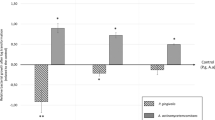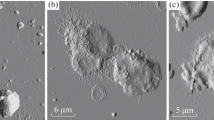Abstract
We investigated the bacteriolytic activity of gingival crevicular fluid (CF) on14C-labeledStreptococcus faecalis, Streptococcus mutans, Staphylococcus aureus, and on whole dental plaque. CF was collected from 100 healthy donors pooled and centrifuged at 200g. CF supernate and a frozen and thawed extract of the pellet were interacted with the different bacterial strains, whileStreptococcus faecalis andStaphylococcus aureus released 60% and 75% of the radioactive label, only 38% of it was solubilized fromStreptococcus mutans, following their incubation with the CF supernate. The findings agreed with results obtained by interacting bacteria with a frozen and thawed lysate of human peripheral blood leukocytes. On the other hand, extracts from frozen and thawed CF pellet were inactive. Further, lipoteichoic acid and lipopolysaccharide were released by CF from Gram-positive and Gram-negative bacteria, respectively. The role of bateriolytic factors, present in CF, as a result of the interaction between microorganisms and leukocytes at inflammatory sites is discussed.
Similar content being viewed by others
References
Cimasoni, G. 1974. The crevicular fluid.In Monographs in Oral Science, Vol. 3. H. M. Meyers, editor. S. Karger, Basel. 85, 94, 95.
Skapski, H., andT. Lehner. 1976. A crevicular washing method for investigation of immune components of crevicular fluid in man.J. Periodontol. 11:19–24.
Attstrom, R. 1970. Presence of leukocytes in crevices of healthy and chronically inflamed gingivae.J. Periodont. Res. 5:42–47.
Cimasoni, G. 1977. Enzyme activity in the gingival crevice.In The borderline between Caried and Periodontal Disease. T. Lehner, editor. Academic Press, London. 13–41.
Tempel, T. R., R. Snyderman, H. V. Jordan, andS. E. Mergenhaoen. 1971. Factors from saliva and oral bacteria, chemotactic for polymorphonuclear leukocytes: Their possible role in gingival inflammation.J. Periodontol. 41:3–12.
Taichman, N. S., W. P. McArthur, andP. Baehni. 1976. Release of lysosomal enzymes from polymorphonuclear leukocytes (PMN) exposed to whole plaque.J. Dent. Res. 55:213B.
Page, R. C., P. Davies, andA. C. Allison. 1973. Effects of dental plaque on the production and release of lysosomal hydrolases by macrophages in culture.Arch. Oral Biol. 18:1481–1495.
Lahav, M., N. Neeman, E. Adler, andI. Ginsburg. 1974. The effect of leukocyte hydrolases on bacteria. I. Degradation of14C labeled streptococci and staphylococci by leukocyte lysates in vitro.J. Infect. Dis. 129:528–537.
Neeman, N., M. Lahav, andI. Ginsburg. 1974. The effect of leukocyte hydrolases on bacteria. II. The synergistic action of lysozyme and extracts of PMN, macrophages, lymphocytes and platelets in bacteriolysis.Proc. Soc. Biol. Med. 146:1137–1145.
Ehrlich, J., M. N. Sela, M. Lahav, andI. Ginsburg. 1977. The bacteriolytic effect of human dentoalveolar purulent exudates and leukocyte extracts.Isr. J. Dent. Med. 26:39–44.
Sela, M. N., M. Lahav, andI. Ginsburg. 1977. Effect of leukocyte hydrolases on bacteria. IX. The release of lipoteichoic acid from group A streptococci and fromStrep, mutans by leukocyte extracts and by lysozyme. Relation to tissue damage in inflammatory site.Inflammation 2:151–164.
Ferne, M., Z. Duchan, S. Rabinowitz, M. N. Sela, andI. Ginsburg. 1978. The effect of leukocyte hydrolases on bacteria. XII. The release of lipopolysaccharide (LPS) fromSalmonella typhi by leukocyte extracts, lysozyme, inflammatory exudates and by serum and synovial fluid, and the mobulation by anionic and cationic polyelectrolytes of LPS release and the sensitization of erythrocytes.Inflammation 3:59–80.
Ginsburg, I., andM. N. Sela. 1976. The role of leukocytes and their hydrolases in the persistence, degradation and transport of bacterial constituents in tissue: Relation to chronic inflammatory processes in staphylococcal, streptococcal and mycobacterial infections and in chronic periodontal disease.Crit. Rev. Microbiol. 4:249–332.
Ne'eman, N., andI. Ginsburg. 1972. Red cell sensitizing antigen of group A streptococci. II. Immunological and immunopathological properties.Isr. J. Med. Sci. 8:1807–1816.
Fiedel, B. A., and R. W.Jackson. 1974. Implications of a streptococcal lipoteichoic acid in renal dysfunction in hyperimmunized rabbits.Abstract, Annual Meeting American Society of Microbiology. 126.
Wicken, A. J., andK. W. Knox. 1977. Biological properties of lipoteichoic acids.In Microbiology. D. Schlesssinger, editor. A.S.M. Washington, D.C. 360–365.
Gatt, R., andE. R. Berman. 1966. A rapid procedure for the estimation of amino sugars as a micro scale.Anal. Biochem. 15:167–171.
Lowry, O. H., N. J. Rosenbrough, A. L. Farr, andJ. Randall. 1951. Protein measurements with the folin phenol reagent.J. Biol. Chem. 193:265–275.
Loe, H. 1967. The gingival index, the plaque index, and the retention index systems.J. Periodontol. 36:610–616.
Moskowitz, M. 1966. Separation and properties of a red cell sensitizing substance from streptococci.J. Bacteriol. 91:2200–2204.
Brandtzaeg, andW. V. Mann. 1964. A comparative study of the lysozyme activity of human gingival pocket fluid, serum and saliva.Acta. Odontol. Scand. 22:441–455.
Dord, C. E., T. Modeer, P. O. Soder, andJ. Bergstrom. 1971. Enzyme activities in experimental gingivitis in man.Scand. J. Dent. Res. 79:510–514.
Van Palenstein Heldermann, W. H. 1976. Lysozyme concentrations in the gingival crevice and at other oral sites in human subjects with and without gingivitis.Arch. Oral Biol. 21:251–255.
Hausmann, E., D. Luderitz, K.W. Knox, andN. Weinfeld. 1975. Structural requirements for bone resorption by endotoxin and lipoteichoic acid.J. Dent. Res. 54:B94-B99.
Dishon, T., R. Finkel, Z. Marcus, andI. Ginsburg. 1967. Cell sensitizing products of streptococci.Immunology 13:555.
Sela, M. N., A. A. Garfunkel, I. Ginsburg, andT. Dishon. 1978. Modulation of human lymphocyte transformation by Gram-positive and Gram-negative bacterial antigens. 12th International Leukocyte Culture Conference, Beer Sheva, No. 260, 66.
Author information
Authors and Affiliations
Additional information
This work forms a part of the DMD thesis of Gad Natan.
Rights and permissions
About this article
Cite this article
Sela, M.N., Natan, G., Lahav, M. et al. Bacteriolytic activity of human gingival exudate. Inflammation 4, 195–203 (1980). https://doi.org/10.1007/BF00914165
Issue Date:
DOI: https://doi.org/10.1007/BF00914165




